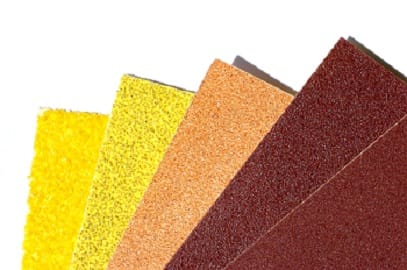As an Amazon Associate, I earn from qualifying purchases.

If you are a DIY enthusiast or a professional woodworker, you know that using a sander is a crucial step in achieving a smooth and polished finish. However, one common problem that you may encounter is the sandpaper slipping off the sander, causing frustration and wasted time. In this article, we will guide you on how to make sandpaper stick to sander and avoid this issue.
Contents
Understanding The Basics of Sandpaper

Before we dive into the methods of making sandpaper stick to a sander, let us first understand the basics of sandpaper. Sandpaper consists of abrasive particles glued to a paper or fabric backing. The grit size, or the number of abrasive particles per square inch, determines the coarseness of the sandpaper. The lower the grit size, the coarser the sandpaper.
Factors That Affect Sandpaper Adhesion
Several factors can affect the adhesion of sandpaper to a sander. The type of sander and sandpaper, the surface of the sander’s pad, and the condition of the sandpaper backing are just a few examples. To ensure that your sandpaper stays in place, you need to consider these factors and choose the right method of attachment.
Methods To Make Sandpaper Stick To Sander
1. Adhesive Backed Sandpaper
One of the easiest ways to make sandpaper stick to a sander is to use adhesive-backed sandpaper. Adhesive-backed sandpaper has a sticky surface that attaches to the sander’s pad without the need for additional glue or clamps. This type of sandpaper is easy to install and remove, making it ideal for quick sanding tasks.
2. Clamp-On Sandpaper
Another common method of attaching sandpaper to a sander is by using clamps. Clamp-on sandpaper has no adhesive backing and requires clamps to hold the sandpaper in place. This method is ideal for sanding larger surfaces or when working with power sanders. Ensure that the clamps are tight enough to prevent the sandpaper from slipping, but not too tight to avoid damaging the sandpaper.
3. Double-Sided Tape
Double-sided tape is a simple yet effective way of attaching sandpaper to a sander. Apply the tape to the sander’s pad and press the sandpaper onto the tape. This method is ideal for irregularly shaped objects or when working with hand sanders. However, be careful not to overlap the tape as it can create bumps that affect the sanding results.
4. Spray Adhesive
Spray adhesive is another method of attaching sandpaper to a sander. Spray the adhesive onto the sander’s pad and press the sandpaper onto the adhesive. This method provides a strong and long-lasting bond but can be messy and time-consuming. Additionally, it can be challenging to remove the sandpaper once the adhesive dries.
5. Velcro Backed Sandpaper
Velcro-backed sandpaper is another popular type of sandpaper that attaches to a sander’s pad with Velcro. The hook-and-loop design allows for quick and easy sandpaper changes, making it ideal for sanding multiple surfaces or when working with different grit sizes. However, the Velcro can wear out over time, requiring you to replace the sandpaper or the pad.
Tips For Proper Sandpaper Attachment

To ensure that your sandpaper stays in place, follow these tips:
- Clean the sander’s pad before attaching the sandpaper to remove any debris or dust that can affect adhesion.
- Choose the right grit size for the task at hand.
- Use the proper method of attachment for the type of sander and sandpaper you are using.
- Avoid overlapping the sandpaper or tape as it can create bumps that affect the sanding results.
- Use a firm grip to press the sandpaper onto the sander’s pad and ensure that it is flat and even.
- Check the sandpaper periodically to ensure that it is still securely attached and replace it if necessary.
By following these tips, you can ensure that your sandpaper stays in place and achieve a smooth and polished finish on your woodworking projects.
FAQs
Can I reuse sandpaper that has lost its adhesion to the sander’s pad?
It is not recommended to reuse sandpaper that has lost its adhesion to the sander’s pad as it can affect the sanding results and may damage the surface being sanded.
What is the best grit size for sanding?
The best grit size for sanding depends on the type of surface being sanded and the desired level of smoothness. Generally, a coarser grit size is used for rough sanding, while a finer grit size is used for finishing.
How often should I replace the sandpaper on my sander?
You should replace the sandpaper on your sander when it becomes worn or clogged with debris. This will ensure that you achieve the best sanding results and prolong the life of your sander.
Can I use any type of sandpaper on my sander?
No, you should use sandpaper that is specifically designed for your type of sander. Using the wrong type of sandpaper can damage the sander’s pad and affect the sanding results.
How do I remove sandpaper that is stuck to the sander’s pad?
To remove sandpaper that is stuck to the sander’s pad, gently peel it off or use a scraper to loosen the edges. Avoid using excessive force as this can damage the sander’s pad.
Conclusion
Sanding is an essential step in achieving a professional-looking finish on your woodworking projects. However, ensuring that the sandpaper stays in place can be a challenge. By understanding the basics of sandpaper and considering the factors that affect adhesion, you can choose the right method of attachment for your sander and sandpaper. Whether you use adhesive-backed sandpaper, clamps, double-sided tape, spray adhesive, or Velcro-backed sandpaper, following the tips for proper attachment can help you achieve a flawless sanding result.



